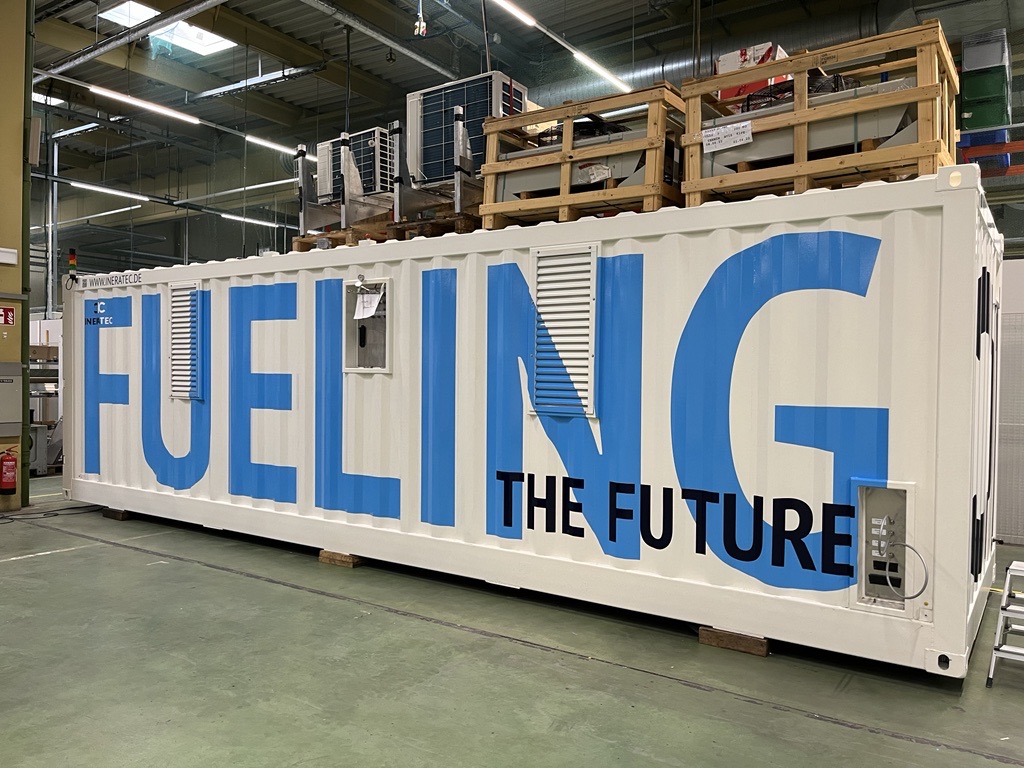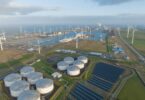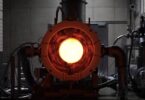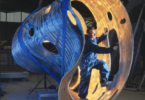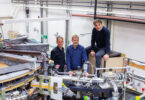E-fuel, a clean fuel source made from hydrogen and CO2 that can be used in traditional combustion engines and distributed using networks that already exist, has the potential to revolutionize the global energy supply, replacing fossil-based fuels in ships, airplanes as well as trucks and cars, with as much as 90% lower emissions.
Building the global infrastructure to support mass uptake of green hydrogen – a type of e-fuel which the International Renewable Energy Agency estimates could account for as much as 12% of global energy use by 2050 -is a systems-level challenge. It will require young technology companies, governments, and large corporates in traditional businesses to cooperate in new ways. German Power-to-X scale-up Ineratec is at the center of a growing number of these collaborations.
On July 4 Ineratec announced that it had formed a public-private collaboration with Germany’s GIZ, an arm of the German government, to promote the production of green hydrogen in Chile. Under the International Hydrogen Ramp-Up program, funded by the German Federal Ministry for Economic Affairs and Climate Action, the partnership, which also includes global industrial services group Ferrostaal, plan to demonstrate a technically feasible and commercially viable e-fuels plant using modular synthesis units. Ineratec’s approach is to place its modular plants next to sources of renewable energy, such as off-shore wind farms, and then convert the energy into green fuels that can be easily stored and transported for use by different sectors.
The German scale-up, which has raised a total of €55 million from government grants and investors that include the corporate venture arm of Japanese car maker Honda, French aviation firm Safran, French global energy company Engie and Münchmeyer Petersen & Co. (MPC) Group, a German family-owned, global group active in shipping, shipbuilding and industrial services and project development in the field of renewables, as well as venture capital firms, plans to target each of these areas. It already has partnerships in place with energy companies across Europe and has opened 13 demonstration facilities. It is building a commercial-scale plant in Frankfurt -currently the largest of its kind in the world – which will, among other off-takes, supply sustainable aviation fuel (SAF) directly to the city’s international airport. It has additionally signed an agreement to build a Power-to-Liquid plant in the port of Amsterdam with the goal of producing up to 35,000 tonnes of e-fuels per year.
Power-to-X technology transforms the surplus energy (Power) that arises when the supply of renewable energy surpasses the demand for local fuels and chemicals (“X”), But since fuel production costs are driven by electricity costs it does not make sense economically to have large scale production in areas like Europe where electricity prices are high.
Ineratec’s plan is to standardize its technology, mass produce its modular plants, and scale-up in places with cheaper and more abundant forms of renewable energy, such as Chile. “This technology was built in Europe, and we want to bring it to the world,” says Philipp Engelkamp, Ineratec’s managing director.
The company has two business models. One is to build modular plants and sell them. The other is to build and operate its own modular plants and sell the e-fuels.
Partnering with larger traditional companies and governments is necessary for e-fuels to reach scale and price parity, says. The U.S. Inflation Reduction Act is offering industry actors a carrot while Europe is using a stick with its tough regulations, says Engelkamp. “Both help,” he says.
If Interatec – a winner of the 2022 German Sustainability Award, in the subcategory Next Economy – can execute on its plan to expand globally with the help of government and corporate partners the company says it is confident that it can get the price of e-fuel down to price parity with fossil fuels by the middle of the next decade. “This is the oil of the future,” says Engelkamp.
Chile’s Pivotal Role
Currently, 95% of the world’s hydrogen is produced using energy derived from hydrocarbon known as “gray” hydrogen, which is created from natural gas, or methane, using steam methane reformation but without capturing the greenhouse gases made in the process. To be considered green the hydrogen needs to be produced using renewable or CO2-free energy and the CO2 needs to come from capturing emissions.
Chile’s plentiful renewable energy sources – from the fierce sun in the Atacama Desert to the windy plains and valleys of Patagonia -make it a potential hub for the sought-after green variety.
An ambitious national green hydrogen strategy aims for Chile to be producing the world’s cheapest green hydrogen by the end of the current decade—and to become one of the top three exporters globally by 2040.
With the help of Ineratec and the German government, the country is beginning to build plants that can produce green hydrogen on an industrial scale.
The latest initiative, involving Ineratec, includes an assessment of the large potential and possible constraints of e-fuel production plants in Chile. It will identify and analyze potential off-takers and feedstock suppliers, as well as different Chilean regions to establish and optimize the design of the plants, to best fit the local requirements. With an eye towards helping to scale the production of e-fuels globally and bringing down costs the collaboration partners will work with local stakeholders from industry, university, and communities to build a sustainable value chain for e-fuels in the country, with the aim of increasing the competitiveness of Chilean industry by reducing its dependence on imported fossil fuels and mitigating the risks associated with fluctuations in global oil prices and supply disruptions.
Another initiative involving Enel Chile, Porsche, Siemens Energy and ExxonMobil, which was announced last year and is also receiving funding from the German government, will produce synthetic e-fuels in Chile from water, wind energy and CO2 captured from the air.
“The potential of e-fuels is huge. There are currently more than 1.3 billion vehicles with combustion engines worldwide. Many of these will be on the roads for decades to come, and e-fuels offer the owners of existing cars a nearly carbon-neutral alternative,” Michael Steiner, Member of the Executive Board for Development and Research at Porsche, said in a statement at a December 2022 ceremony marking the opening of the Haru Oni e-fuels plant in Punta Arenas.
The south of Chile offers ideal conditions for the production of e-fuels, with the wind blowing for around 270 days a year and enabling the wind turbines to operate at full capacity. Punta Arenas is also located close to the Strait of Magellan. From the port of Cabo Negro, the synthetic eFuel can be transported just like traditional fuels all over the world, and be distributed using the existing infrastructure.
Up In The Air
There is a long journey ahead to get green hydrogen to fly. Take the case of sustainable aviation fuel (SAF).
The aviation industry has agreed to ambitious targets to cut its carbon footprint. Now it needs to find enough sustainable fuel to help it achieve those goals. In September 2021 60 companies in the World Economic Forum’s Clean Skies For Tomorrow Coalition – whose mission is to accelerate the deployment of sustainable aviation fuel (SAF) – committed to working together to power global aviation with 10% SAF by 2030. (More have joined since then). Synthesized from sustainable, renewable feedstocks such as municipal waste, agricultural resides and waste lipids, SAF have already fueled more than 250,000 commercial flights.
However, difficulties remain in getting SAF to scale up production due to its prohibitively high price gap with fossil-based jet fuel, resulting in a chicken and egg problem with supply and demand, according to the Forum. Costs will fall if production scales up, but in the meantime fuel providers are struggling to be competitive with fossil fuels and face high risks associated with policy and investment uncertainty.
In 2019, fewer than 200,000 metric tons were produced globally — less than 0.1% of the roughly 300 million metric tons of jet fuel used by commercial airlines, according to a November 2020 report by the Forum and McKinsey. The report found that if all publicly announced SAF projects are completed, volumes will reach just over 1% of expected global jet fuel demand in 2030.
To accelerate the roll-out of carbon-neutral fuels for aviation Ineratec announced in March that it is partnering with Switzerland’s Synhelion, a global pioneer in the field of sustainable solar fuels that was spun-out of the Swiss Federal Institute of Technology (ETH Zurich) in 2016 to decarbonize transportation. Synhelion has developed a technology to produce next-generation synthetic fuels. At the core of the solution is a proprietary process that converts solar heat into syngas. This syngas is then fed into Ineratec’s modular synthesis plant and converted into liquid fuels via the Fischer-Tropsch process. By combining these technologies, Synhelion and Ineratec says they can produce clean solar fuels that offer an economically viable, efficient, and scalable substitute for fossil fuels that is fully compatible with existing global fuel infrastructure. Synhelion is currently implementing an industrial-scale plant to produce sustainable kerosene from solar energy in Jülich in North Rhine-Westphalia, Germany, and has chosen Ineratec as partner for the fuel production from the solar syngas. The modularity and cost-efficiency of both technologies are key drivers to demonstrate the profitable and scalable production of solar fuels. After that, both partners plan to rapidly scale their fuel production with support from industry partners such as Swiss International Air Lines and Lufthansa Group.
Ineratec and Synhelion are competing with at least nine other SAF companies. One of them is LanzaJet, a U.S.-based sustainable fuels technology company and renewable fuels products, which produces SAF and renewable diesel from low-carbon, sustainable ethanol sources, Shell, Vattenfall and British Airways have separately invested in the company.
Engelkamp says he welcomes other providers of SAF because many players will be needed to help meet the demand for e-fuel and drive the price down.
Biofuels, biomass-derived fuels from plants or waste could lower CO2 emissions by 20%–98% compared to conventional jet fuel.The first test flight using blended biofuel was in 2008, and in 2011 blended fuels with 50% biofuel were allowed in commercial flights. But biofuel is limited by the amount of biomass. “When we look into the future there will be an upper limit to biofuels,” says Engelkamp. “Synthetic fuels will play a crucial role because the amount of renewable energy is unlimited.”
Ineratec has already started the manufacturing phase and site construction for its pioneer plant in Frankfurt, with full operation scheduled for 2024. “We are already overbooked,” says Engelkamp. “We are trying to come up with the right formula for the next plants we build to leverage the large demand from the aviation and shipping industries.”
Kickstarting Shipping’s Use OF Synthetic Diesel
In May Ineratec signed a Memorandum of Understanding with Zenith Energy Terminals, a midstream company that owns and operates renewable fuels, crude oil, petroleum products, chemicals and gas storage across North American, Europe and Latin America, to build a Power-to-Liquid plant in the port of Amsterdam.
The plant is planned to produce up to 35,000 tonnes of e-fuels per year, from locally generated and imported green hydrogen. Up to 100,000 tonnes per year of CO2 w will be captured from Dutch industry and used as a key feedstock to the Ineratec process.
The sustainable e-fuels which Ineratec will produce in Amsterdam will contribute to the Dutch goal of achieving a circular economy and reducing greenhouse gas emissions. Ineratec plans to produce and refine e-fuels including sustainable kerosene, clean diesel and CO2-neutral gasoline, delivered directly to offtakers active in shipping, aviation and road transportation as early as 2027.
The port of Amsterdam, with its strategic location in Europe, was chosen as the preferred site for the plant, given its access to key infrastructure.
Maritime transport, the backbone of global trade, is responsible for about 2.5% of global greenhouse gas (GHG) emissions, according to the third International Maritime Organization (IMO) Greenhouse Gas report.
Emissions are projected to increase significantly if mitigation measures are not swiftly put in place. The report found that greenhouse gas emissions of shipping increased from 977 million tons in 2012 to 1,076 million tons in 2018, a 9.6% rise. Over this period the carbon intensity of shipping operations improved by about 11%, but these efficiency gains were outstripped by growth in activity.
Unless this trend is reversed by 2050 shipping emissions could -under a business-as-usual scenario increase by up to 50% relative to 2018, undermining the objectives of the Paris Agreement, according to the Fourth IMO Greenhouse Gas Study, which as was published in 2020 and prepared by CE Delft in the Netherlands and an internal consortium comprising consultancies, research institutes and universities.
In January of this year MPC Container Ships and Ineratec signed an agreement for the supply of synthetic Marine Diesel Oil (MDO) made from biogenic CO2 and renewable hydrogen, with delivery set to start in 2024.
Due to its drop-in compatibility, synthetic MDO can directly replace conventional fossil fuels used today by existing vessels. Early collaboration between e-fuel providers and offtakers across industries is an important factor for scaling up production volumes and driving decarbonization. With this agreement, MPC Container Ships said that it will kickstart the transition towards carbon neutral, synthetic diesel in the shipping sector.
“While there will be a variety of different fuels in the future, the synthetic MDO produced by Ineratec is of particular relevance as it can be used both in conventional combustion engines on our existing vessels and as pilot fuel for our methanol powered new buildings,” Constantin Baack, CEO of MPC Container Ships said in a statement.“As a key building block of the decarbonization of our industry, we expect that green fuels may come to be included as part of vessel hire, in which case it will be vital for MPCC to have a strong relationship with fuel providers,” he said.
Ineratec is one of the few green fuel companies that has already built production facilities and realistically meet demand from the maritime industry in the short term.
The Time To Ramp Up Is Now
Companies in the automotive sector are also currently testing Ineratec’s e-fuels. Fossil-free fuels could use the current infrastructure of distribution – from refineries to gas stations- if there is political will to make it happen, meaning someday consumers might be able to pump Ineratec’s e-fuels directly into their cars. For the moment, though, Ineratec’s focus is on aviation and shipping and leading the ramp-up of e-fuel production at additional sites world-wide, with the aim of reducing megatons of CO2 emissions and abating climate change.
There is no time to waste, says Engelkamp. “The time to ramp up is now. We want to supply as much as possible of the demand. This is our goal. There is a need to move forward. We see that as our role: to really be the first and the largest.”
This article is content that would normally only be available to subscribers. Sign up for a four-week free trial to see what you have been missing.
To read more of The Innovator’s Energy Transition articles click here.

